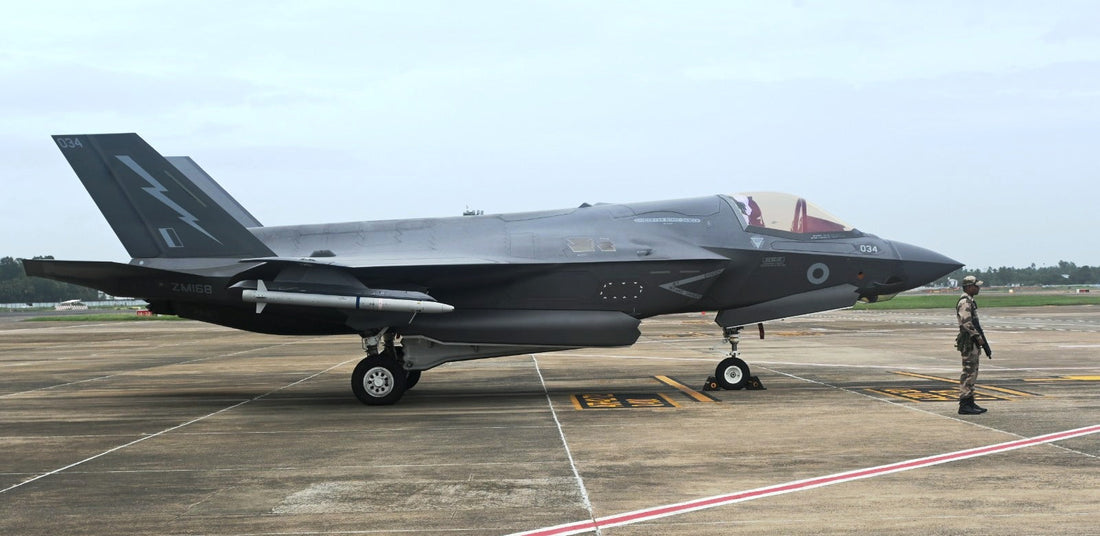CISF Protects British F-35B Fighter Jet After Emergency Landing in Kerala

A dramatic turn of events unfolded over the weekend when a Royal Navy F-35B Lightning II fighter jet made an emergency landing at Thiruvananthapuram International Airport in Kerala, India, following a fuel shortage and technical malfunction. The incident, which took place late Saturday evening, June 14, has drawn global attention, with the Central Industrial Security Force (CISF) swiftly stepping in to secure the highly advanced stealth aircraft.
The Emergency Landing
Flight radar data revealed that the £80 million ($100 million) fifth-generation fighter jet—part of the UK's Carrier Strike Group embarked on HMS Prince of Wales—broadcast the emergency transponder code SQUAWK 7700 around 9:00 PM while flying off the Kerala coast. The aircraft, which was en route to a multilateral deployment in the Indo-Pacific region, experienced issues mid-sortie over the Indian Ocean.

Using its Short Take-Off and Vertical Landing (STOVL) capabilities—thanks to an advanced Rolls-Royce lift fan and integrated sensor suite—the pilot safely landed the aircraft at the nearest operational airfield, averting a potential crisis.
The F-35B is a cornerstone of modern aerial combat, prized for its stealth, sensor fusion, and adaptability. Its emergency landing on Indian soil is a rare and diplomatically sensitive occurrence, highlighting the operational risks associated with deploying high-end military platforms across vast geographies.
CISF’s Swift and Disciplined Response
The CISF, India’s elite security force responsible for safeguarding critical infrastructure, responded immediately to the incident. With a well-established reputation in aviation security across 65 Indian airports, CISF personnel cordoned off and secured the fighter jet within minutes of landing. Images circulated online showed CISF officers in high-visibility vests standing guard beside the aircraft on the tarmac, reinforcing the force’s professionalism and readiness.

A CISF statement posted on X (formerly Twitter) read:
“Defining Security Beyond Borders. CISF swiftly secured the Royal Navy F-35B fighter jet after its emergency landing at Thiruvananthapuram Airport.”
The post also tagged several Indian government agencies, signaling a coordinated and high-level response.
Strategic Context and Public Fascination
The presence of the F-35B in Indian airspace ties back to recent Indo-UK joint naval exercises held in the Arabian Sea earlier this month. HMS Prince of Wales—on deployment since April 2025—is equipped with F-35Bs, UAVs, and advanced naval assets, symbolizing deepening strategic cooperation between New Delhi and London in the Indo-Pacific.
Meanwhile, the emergency landing has sparked a wave of curiosity and memes on Indian social media. On X, users joked about reverse-engineering the fighter jet or treating it as "maal-e-ghanimat" (war booty), with light-hearted references to Indian film characters “inspecting” the aircraft. While humorous, these reactions also reflect a broader fascination with the technological leap the F-35B represents. A 2023 Quora analysis once described the aircraft as embodying a 60-year leap in aerospace technology, underscoring the sophistication gap India’s indigenous aerospace programs still aim to bridge.
Silence from the UK, Uncertain Next Steps
As of 8:26 PM IST, Tuesday, June 17, neither the UK Ministry of Defence nor Lockheed Martin—the aircraft’s manufacturer—has issued a public statement regarding the incident or the jet’s current operational status. Coordination between Indian and British authorities is expected to continue behind closed doors, especially given the jet’s classified systems and the sensitive nature of any inspection or recovery effort.
Broader Implications
This incident not only exposes the operational vulnerabilities of cutting-edge military technology during extended deployments but also showcases the efficiency and reliability of India’s security and aviation infrastructure. For the CISF, it reinforces its capability to respond swiftly even in unexpected, high-profile scenarios. For India and the UK, the event may further strengthen defense cooperation and mutual trust in sensitive military engagements.
As the F-35B remains grounded in Kerala under CISF protection, it continues to draw both attention and admiration—its sleek silhouette on the tarmac symbolizing a rare intersection of global defense, diplomacy, and public imagination.



















